
|   |

|   |
Stage vs screen: Ramya Harishankar demonstrates the same dance in film and in performance - Shveta Arora e-mail: arorashveta1806@gmail.com April 14, 2024 On 11 January 2024, Ramya Harishankar, an eminent Bharatanayam dancer and teacher based in the US, screened two of her dance films, Aasha and Bhumika, at the IHC in Delhi. The event had been organized by Kri Foundation and the setting was very intimate in the smaller Amaltas auditorium rather than the cavernous Stein. Ramya Harishankar is the artistic director of the Arpana Dance Company and school, a premier school of Bharatanatyam in California and the United States. She has trained under Swamimalai K. Rajaratnam and Kalanidhi Narayanan. She has been honoured with various recognitions by Los Angeles, Orange County and the city of Irvine for her contribution to the arts, including successfully running the ADC for over 40 years. The two dance films that Ramya made were shown first. 'Bhumika' is about climate change and 'Aasha, until we meet again' commemorated the 20th anniversary of 9/11. The first to be screened, 'Aasha', means hope. The setting was the door of the nayika's house, where she comes to wait for the return of her lover. As she looks at the path, eyes expectant, she reminisces about his touch on her hand and his caressing her cheek. She watches the day turn to dusk with the setting of the sun, shown through the gaze moving from up to down, and yet she is not despondent. This is the art of dance films, which got its boost during the COVID19 lockdowns. In the frame was just the torso, with the eyes moving to convey the emotion and the hands just conveying the sensation of being touched. It says so much in a few minutes and the music by Rakesh Chaurasia made for the perfectly powerful melody. The abhinaya was impressive. 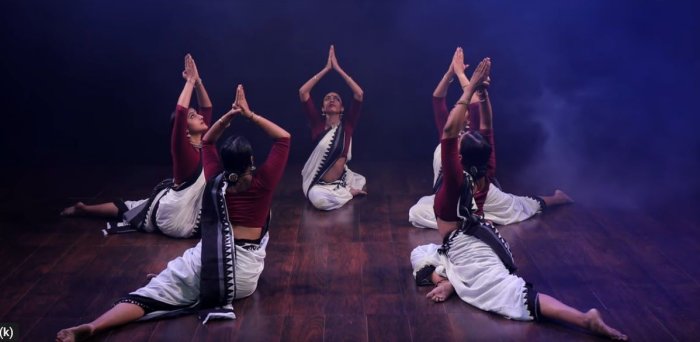 Bhumi pranam The next film was 'Bhumika - a mother's lament'. Here again, the media used were the music, abstract choreography with the group of 5 dancers in white saris, the voiceover narrating the concept behind the dance and the images of earth that appear before each section. The first section was the bhumi pranaam, where the dancers prostrate themselves in front of mother earth. Earth is one of the five elements making up life, and we return to it in death. Prakriti is the divinity that we worship, the life within and without us. The dancers performed the steps like the surya namaskar. The next section was titled balance and imbalance, sama and visama. The images showed mountains, land and oceans, a storm progressing. The choreography was symbolic - how the dancers begin their jathis not as a group but with a time lapse, 3 dancers together and 2 a little later, and how that disharmony affects you. They move in different directions, not facing each other, moving in discord, showing the five elements and how the man-made imbalance has affected the balance in nature, the havoc it has created. 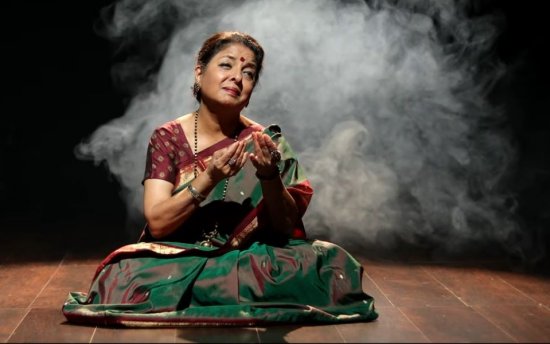 Ramya Harishankar portraying a mother's lament The next commentary was very poignant, calling upon the compassion in humans. Any right-thinking mind would be disturbed by these words. The earth, speaking as a mother, calls to the compassion in humans. Compassion can totally change the world around us. It can undo the wrong of vices, nurture nature, overcome the hurricanes and storms in our path. Compassion can turn things around. But the pleading of the mother is falling on deaf ears. The images showed the changes and damage the surface of the earth has suffered over time. The scars on the surface do not prevent further scarring, neither do they prevent the scars from becoming so huge that they engulf the sinners. The images were disturbing as they showed the face of the earth defaced. The rage and vagaries of nature may overpower you even before you have the time to feel remorse. The commentary was hard-hitting. Ramya did a solo seated, an abhinaya piece. It was very appropriately titled 'a mothers lament'. Ramya as the mother makes requests to the child, who is acting haughty and chooses to ignore her. She is distraught - 'I have been calling out to you and pleading, but you pay no heed. You take it in one ear and throw it out the other.' She grabs his hand to make him listen to her, but he does hot heed her. He pushes her away. She burns and turns to ashes - 'I embrace you in a motherly manner and you keep trying to get away.' Ramya did a very emotive piece and it was her eyes that expressed the most. The two movies were so impressive that they left a mark. Aasha ; Bhumika Here we see a coming together of the arts of dance, music and moviemaking. The first one was plain abhinaya, with Rakesh Chaurasia's flute in the background. The second had the element of Google images of the earth and commentary, followed by expressing the same through nritta in the first two sections and in the last segment, powerful abhinaya by Ramya, showing how mother earth is lamenting our abuse of her. After the screening of the movies was the question and answer session with Kathak dancer Sangita Chatterjee and Arshiya Sethi of the Kri Foundation. This was followed by the performance of two abhinaya pieces by Ramya. She spoke about how her love for the old padams and javalis, their music and lyrics, was not enough to make them relatable to the current generation of her students in the US. She had to contemporize them to make them relatable. The first piece was a 16th century padam. Here, the nayika says that she cannot keep going on and on about why he has not come. Then, she was youthful, and now, she is astute. Their paths have diverged, not to meet again. 'I was giddy and waited and watched the path for him to return, which he would not. I was heartbroken then, but why talk about it now? I am content now and full of bliss.' In her very pertinent abhinaya, Ramya showed the nayika waiting the entire night for her lover to arrive. As the day breaks, she burns with despair and anger. But now, as she has grown older, she tells him to go away and not to come back for she does not desire him anymore. She is content now and has the right to be happy, with or without him. She did not need her lover of yore to give her the agency to feel complete and to define her. The next piece was a khandita nayika who tells her lover to stay away. 'You have been flirting with other women, sweet talking them, ogling them from head to toe. Women are more than just bodies; they have hearts and minds too. For now, keep that in mind - do not make false promises, and stay away.' The abhinaya showed how she snatches her hand away when he tries to take it and brushes away his efforts at touching her. She tells him how he has been looking at beautiful women and has been involved in playful flirtations with them. The abhinaya was powerful, and so was the interpretation, which made the concept relatable. At times, one gets tired of the nayika either getting extremely saddened or angered by the fact that her lover has not arrived, and one feels like telling her, 'Go get a life.' In the present times, when many women have become independent, it is painful to see dancers still stuck to the old interpretations, lamenting and maligning the 'other woman'. It was an enlightening evening. Below is an account of the interaction between Arshiya Sethi, Ramya Harishankar and Sangita Chatterjee. Arshiya: We will be talking to Ramya about her abhinaya skills, her special training and the challenge of working in an international scenario, where you face the task of explaining everything from scratch, since the audience may not be aware of the topic, which is very different from what it is here in India, where the audience is aware of the stories and can actually keep a visible count (of the beats), which at times can be unnerving. We are going to talk a little bit about the films with Sangita Chatterjee, who is a famous Kathak dancer. One of the reasons Kri Foundation decided that 20 years of dance lens is good enough is that there is now a new generation of dancers that is working very well and sensitively on dance films. I did not want the bargad ka ped (banyan tree) effect - that only I am there and letting no one else bloom. So I am happy to have Sangita here join us in this discussion. With Sangita, we did a long festival of dance films called 'Chakshu' since there was no other option besides the digital space during COVID. It is a series and we intend to keep it going with sequels. Sangita's films 'Quest' and 'Mirage' have been greatly celebrated. One thing that we get to see in dance films or dance videos is that there are very rapid cuts due to which one does not see sequences. This ('Bhumika') is a two-in-one film as I see it: it allows us to understand the dance as you present it and secondly, the push which is very urgent that a film can give you; in a short time you can say a lot. I would like you to comment on this treatment. Ramya: It is always good to hear another person's perspective of your work. I would like to tell you that my students in LA, when they saw 'Bhumika', interpreted the smoke on stage, that was created as a visual, as the smog - that the earth was choking on smog. I think as Delhiites you can relate to that. At one point, LA was also known for its smog, though it is doing a little better now. Coming to the films, 'Bhumika' was made first during COVID. If anybody had asked me before 13 March 2020 to teach online or have a conversation online, I would have said a definite no. But 14 March we were teaching online. We did not have an option. And in 2021, a friend in LA who does contemporary work, Donna Sternberg, called. Her field of interest is science and art. She created a production called 'Awe and Wonder', on climate change. She invited me to create a piece for it in Bharatanatyam. The other dance forms were hip-hop, break dance and contemporary. Of course, we could not meet during COVID. We would practice online on a Zoom meet. And till a week before, we did not know how we would shoot because most facilities were not available due to COVID. But the good news is that it came about. One thing that I would mention here is that our effort was keeping the integrity of the form we are all trained in and staying with the vocabulary, and yet stepping out. This is an interesting place to be because you don't have to completely lose the structures etc. but you also don't have to stay within the box. The Bhoomi pranaam was inspired by the pushpanjali, which made sense to me. As dancers, we know that first of all, we have to pay obeisance to Mother Earth. The second is balance and imbalance. Imbalance in our lives means that the body gets diseased, be it physically, mentally or psychologically. Imbalance in dance means that all dancers are dancing out of sync, doing their own thing and not in order. How would that look? The third piece was inspired by a Tamil viruttam where the devotee asks Muruga that out of your six heads, which scorn me, could just one look at me with kindness? Of all your hands, could not one be spared to bless me? This hymn has been flipped: what if Mother Earth, the immortal, asks of us - out of your many faces, is there not even one that could look at me kindly? The advantage with film, even though we have a structure with music, we improvise intuitively in the moment. The music for that was composed by my son, who is an aspiring musician. When we shot the film and came back, he told me that he was not happy with the timing of my falling, but I told him I was listening to the music and responding so it's okay. When the film was finally edited, I was falling at the right time. And I asked him (how), because I didn't fall at the 'right time'. And he told me that he had re-edited the music to suit the fall! He is a perfectionist and wanted everything to be a particular way. That is privilege one can have only in a film and not in live performance. 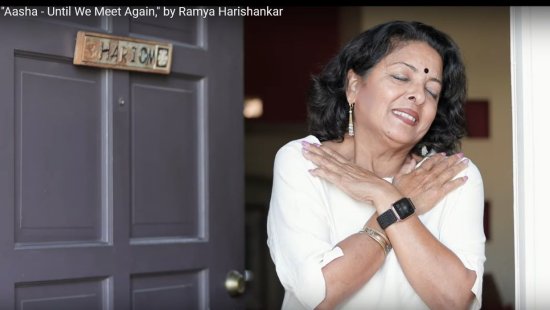 Ramya Harishankar in Aasha For 'Aasha', there are two things. Firstly, during COVID, there were many festivals that wanted a 2-minute clip. I was very respectful of that and created something that was only 2 minutes. But then there would be videos of people that were anything from 6 to 15 minutes in the same series! And this is something even my guru has said: I just watch the pushpanjali and if it doesn't grab me, I just leave. How long does it take for you to engage the audience? Do you need to dance 15-20 minutes or can you dance for 2-3 minutes and still get your point across? So that was the experiment, and most importantly, it was the 20th anniversary of 9/11. Of course, 9/11 changed the world but in the US, it was huge for us. Plus I also think it's really for any of us who has lost a loved one and always had a little bit of hope that we're going to meet them again somewhere sometime. It kind of came from that hope. Sangita: There are a few questions inspired from observing the films. Both films are very engaging. The two concepts are strong enough and could be performed even without the camera, on stage. So how much importance did you give to the camera, and how much to choreography without it? Ramya: I think when you perform, at some point you kind of zone in and then the camera and the audience become something like a voyeur trying to peep in. That is very important. When you do a choreography, the camera should be documenting rather than dictating what you do. 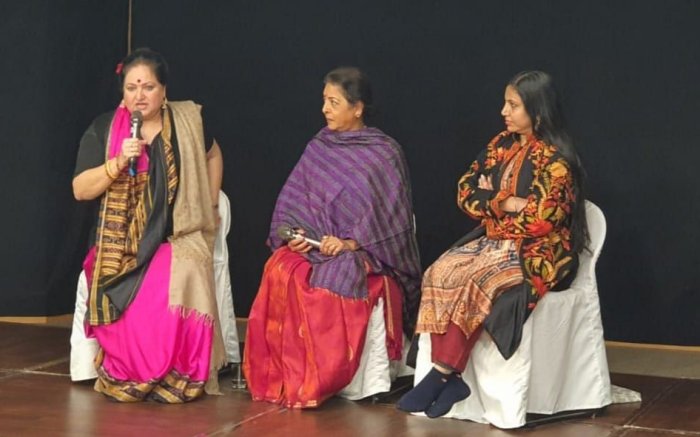 Arshiya Sethi, Ramya Harishankar, Sangita Chatterjee Sangita: That's very interesting. In our classical dances, the face is very important; the camera cannot dictate what we do on the stage. But the camera can focus on the upper part of the body, showing all the facial details and the eye expressions, things that can get missed in the proscenium performance. Like in 'A Mother's Lament', you did the gesture of listening from one ear and taking it out of the other, which can be ineffective on stage. So it was a beautiful way of bringing the camera and dance together since our dance is very personal and emotive and the facial expressions are important. Ramya: 'Bhoomika' was our first ever attempt at making a dance film and we let the camera be just an observer. We did not manipulate the camera. Of course, you can focus the camera on what you want the audience to see. And for that, you need a big budget also, which we did not have. We just let the camera roll. For 'Bhumika', the practice was online, with these girls sitting distantly and coordinating and coming together only in the last week. They did not have a set rhythm and had to breathe together to keep timing. 'Aasha' was shot in front of my front door. The cameraperson was a PhD student in south-east Asian studies and he has worked with me on a couple of films. He suggested that we should move from black and white to colour. And I also wanted to experiment with silence. I sent it to a couple of friends for their response. Somebody told me that they were looking for the sound. They told me that it is not going to work. People are going to be looking for some sound in the 3 minutes. Guni sent me a few pieces to select from and then the composition by Rakesh Chaurasia worked well for me. It just gave me goosebumps. I thought it just suited the piece. I called up Rakesh and told him that I am going to be using his piece for my movie. I did show it to Rakesh and he suggested some more music I could use - 'I have all these recordings you could try!' he said. Arshiya: This is just a pointer, but you will have to ask Rakesh Chaurasia to free the piece from copyright issues so that you can use it. That is the legal point of view for the artists that we are fighting for, the algorithm. People should know about copyright. Question from the audience: To me, dancing for the camera would actually involve extra work, especially for the abhinaya sections. How many times did you have to actually do the piece to get it that perfectly? On stage we would have done it once, in the moment of it. Did you have to record it more than once? Ramya: Once. During COVID, there was a certain number of hours that you could get the space for. We did it twice so that we could copy-paste. That was about it. I also spoke to Ramya Harishankar later. Below are the excerpts. Comparison between the abhinaya in the movie and abhinaya performed live at the event For me, everything is a performance, in the sense... but also own what you do, make it your own story. So it isn't separate for me. But the films were made with a particular idea in mind and they were not pre-existing songs or scriptures or Vedas - nothing. I wrote my own story. Even when we do padams or javalis, we are authors because we are writing the inner monologue we are interpreting. The words say one thing and then we go beyond the words to interpret from our own perspective. In both films, we wrote our own story. We were not interpreting any song etc. It was a unique experience doing that. In 'Aasha', it's only 3 minutes long. In abhinaya, there is a rhythm, there is a hidden cadence to that, just as in theatre, when you speak. I like to write my own storyline, so to speak. I look at Bharatanatyam and abhinaya as a language. It doesn't have to be religious or poetry. It's like English or Hindi - you can speak anything in it. You don't have to do only Kshetrayya padams or only religious songs or devi etc. But of course, you have to have respect for the form and the integrity of the form. Many people veer away to one side and I'm not faulting them. But for me, there is a comfort zone but within the comfort zone, how do you expand that? It's important. The visuals juxtaposed in 'Bhumika' That's important because people don't see how the world is changing. It appeals across the board because there are no words, just emotions and thought. We performed 'Bhumika' live in the US at dance festivals and even people who are not Indian or not Bharatanatyam dancers have responded and said it reminds us of what we're doing to the planet. The different interpretation in the abhinaya pieces Actually, 'Mutta vaddura' originally says 'oh, who is she?' treating the other woman with disdain, but I thought, we as women should not be putting each other down. So ask, who am I to you and who is she that you can just treat us like this without respect for our hearts and minds? We're not just bodies. I speak from the perspective of women, not just me. 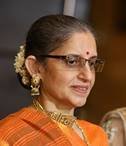 Shveta Arora is a dance-mad writer who chronicles classical dance events in Delhi (and also those online). In 2009, she started the blog Kala Upasana at delhiculturecomment.blogspot.com, where she began posting her own writing along with photographs clicked by Anoop Arora, her husband. She's been dancing all her life as a devotee, but resumed her formal training in Kathak in her 50s and has passed her fifth year Kathak exams. |